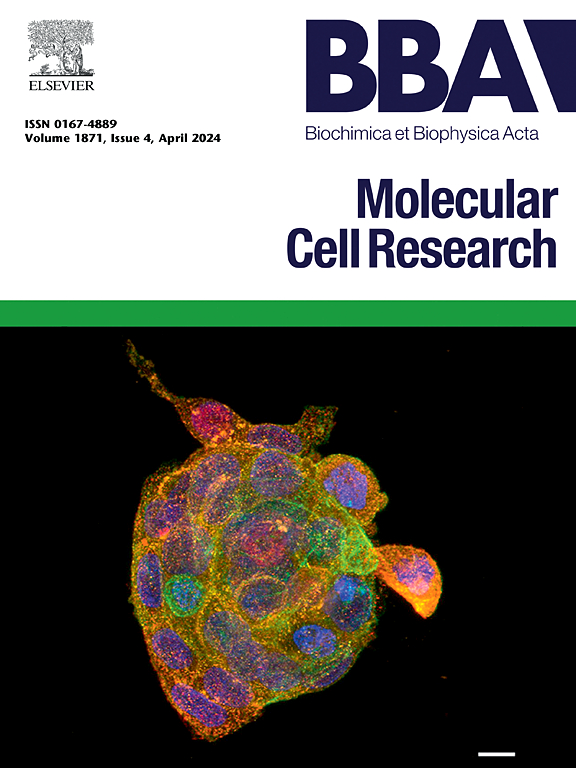Fidgetin 家族的进化和功能分化。
IF 4.6
2区 生物学
Q1 BIOCHEMISTRY & MOLECULAR BIOLOGY
Biochimica et biophysica acta. Molecular cell research
Pub Date : 2024-10-30
DOI:10.1016/j.bbamcr.2024.119870
引用次数: 0
摘要
Fidgetin(FIGN)家族由 FIGN、Fidgetin-like 1(FIGNL1)和 Fidgetin-like 2(FIGNL2)组成,是一组重要的微管分裂蛋白。这些蛋白具有对 ATPase 活性和六聚体组装至关重要的保守 AAA+ 结构域。本综述深入分析了 FIGN 家族成员的进化和功能分化,强调了它们在细胞骨架动态组织中的作用。我们还进一步探讨了它们在不同物种、系统和亚细胞定位中更广泛的生物学功能。虽然 FIGN 家族是保守的,但每个成员都表现出独特的结构特征和功能,这反映了它们在进化过程中的适应性。FIGNL1 存在于各种动物物种中,而 FIGNL2 则是脊椎动物特有的,这表明其进化起源较晚。此外,同源分析表明,与经历了重大进化变化的FIGNL2相比,FIGN位于更保守的基因组区域。FIGN成员的表达模式在不同生物和组织中也有所不同。例如,与低等脊椎动物相比,FIGNL2在哺乳动物神经系统中的表达明显减少。FIGN 家族成员在微管切断、细胞分裂和 DNA 修复中发挥着不同的作用。具体来说,FIGN参与细胞分裂和神经元再生,FIGNL1参与轴突生长和DNA修复,FIGNL2参与细胞迁移和血管发育。它们在这些过程中的参与突出表明,它们是某些癌症的潜在生物标志物,也是影响神经系统和心血管发育疾病的治疗靶标。FIGN 家族的所有这些进化见解和功能区别为了解细胞骨架调控及其对健康和疾病的影响提供了一个全面的框架。本文章由计算机程序翻译,如有差异,请以英文原文为准。
Evolution and functional divergence of the Fidgetin family
The Fidgetin (FIGN) family, which comprises FIGN, Fidgetin-like 1 (FIGNL1), and Fidgetin-like 2 (FIGNL2), is a vital group of microtubule-severing proteins. These proteins feature a conserved AAA+ domain essential for ATPase activity and a hexameric assembly. This review provides an in-depth analysis of the evolution and functional divergence of the FIGN family members, highlighting their role in the dynamic organization of the cytoskeleton. We further explore their broader biological functions across various species, systems, and subcellular localization. Although the FIGN family is conserved, each member exhibits unique structural characteristics and functions that reflect their evolutionary adaptations. FIGNL1 is found across animal species, while FIGNL2 is specific to vertebrates, thereby indicating its more recent evolutionary origin. Moreover, synteny analysis has revealed that FIGN is located in a more conserved genomic region compared to FIGNL2, which has undergone substantial evolutionary changes. The expression patterns of the FIGN members also vary across organisms and tissues. For example, FIGNL2 shows a notably reduced expression in the mammalian nervous system compared to that in lower vertebrates. The FIGN family members have distinct roles in microtubule severing, cell division, and DNA repair. Specifically, FIGN is involved in cell division and neuronal regeneration, FIGNL1 in axonal growth and DNA repair, and FIGNL2 in cell migration and vascular development. Their involvement in these processes underscores their role as potential biomarkers for certain cancers as well as therapeutic targets for diseases affecting the nervous system and cardiovascular development. All these evolutionary insights and functional distinctions of the FIGN family offer a comprehensive framework for understanding cytoskeletal regulation and its implications in health and disease.
求助全文
通过发布文献求助,成功后即可免费获取论文全文。
去求助
来源期刊
CiteScore
10.00
自引率
2.00%
发文量
151
审稿时长
44 days
期刊介绍:
BBA Molecular Cell Research focuses on understanding the mechanisms of cellular processes at the molecular level. These include aspects of cellular signaling, signal transduction, cell cycle, apoptosis, intracellular trafficking, secretory and endocytic pathways, biogenesis of cell organelles, cytoskeletal structures, cellular interactions, cell/tissue differentiation and cellular enzymology. Also included are studies at the interface between Cell Biology and Biophysics which apply for example novel imaging methods for characterizing cellular processes.

 求助内容:
求助内容: 应助结果提醒方式:
应助结果提醒方式:


